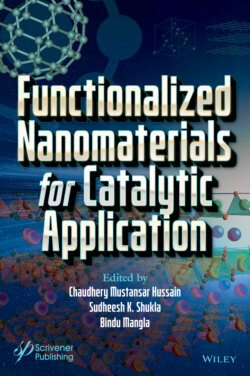Читать книгу Functionalized Nanomaterials for Catalytic Application - Группа авторов - Страница 10
Оглавление
Preface
With the rapid development in nanotechnology, it is now possible to modulate the physical and chemical properties of nanomaterials with molecular recognition and catalytic functional applications. Such research efforts have resulted in a huge number of catalytic platforms for a broad range of analytes ranging from metal ions, small molecules, ionic liquid and nucleic acids down to proteins. Functionalized nanomaterials (FNMs) have important applications in the environmental, energy and healthcare sectors. Strategies for the synthesis of FNMs have contributed immensely to the textile, construction, cosmetics, biomedical and environmental industries among others. These areas are considered a key platform for a wide range of applications, consequently becoming a top priority for science and technology policy development since they are already involved in the production of various modern products, especially in electronics, healthcare, chemicals, cosmetics, composites and energy. Due to their ultra-small size, nanostructured FNMs have extraordinary physical and chemical properties such as unique optical, electrical, thermal, magnetic and adsorption characteristics. The large specific surface area of FNMs can certainly improve their current application even at the industrial as well as academic scale. In addition, FNMs of various compositions and morphologies can provide powerful tools for advanced industrial techniques. Therefore, FNMs-based techniques can play a vital role in numerous industrial procedures such as, for example, by increasing sensitivity, magnifying precision and improving the production limit. Moreover, freedom to functionalize nanomaterials with various chemical groups can also increase their affinity toward respective counterpart analytes, which is very desirable for selective manufacturing of certain products.
This book highlights the design of functionalized nanomaterials with respect to recent progress in the industrial arena and their respective applications. It presents an inclusive overview encapsulating FNMs and their applications to give the reader a systematic and coherent picture of nearly all relevant up-to-date advancements. Herein, functionalization techniques and processes are presented to enhance nanomaterials that can substantially affect the performance of procedures already in use and can deliver exciting consumer products to match the current lifestyle of modern society. Advanced undergraduate and graduate students and industrial professionals will find this book a good source of knowledge that will act as a guideline for their studies and research. Because of the integral nature of the topics, it will also be of interest to a broad spectrum of audiences, including industrial scientists, industrial engineers, nanotechnologists, materials scientists, chemists, physicists, pharmacists, biologists, chemical engineers, and all those who are involved and interested in the future frontiers of nanomaterials. In other words, it was devised as a reference book for researchers and scientists who are searching for new advanced techniques for various catalytic applications.
Among the editors and contributors to this book are prominent researchers, scientists and true professionals from academia and industry. We are very thankful to all the authors of the chapters for the wonderful and passionate effort they displayed while working on this book. And a special thanks to Martin Scrivener and the entire team at Scrivener Publishing for their dedicated support and help during the process of compiling and publishing this book.
Chaudhery Mustansar Hussain, Ph.D. Sudheesh K. Shukla, Ph.D. Bindu Mangla, Ph.D.
